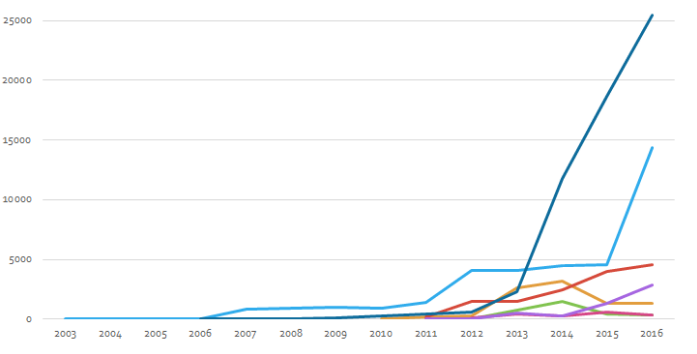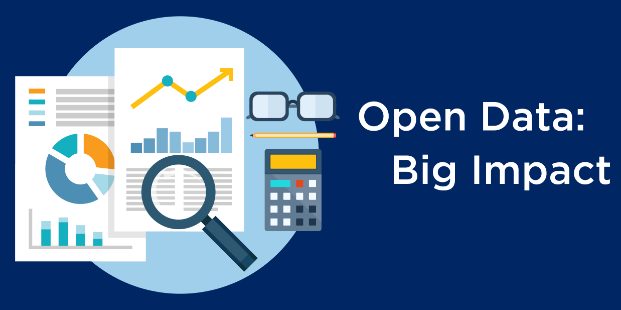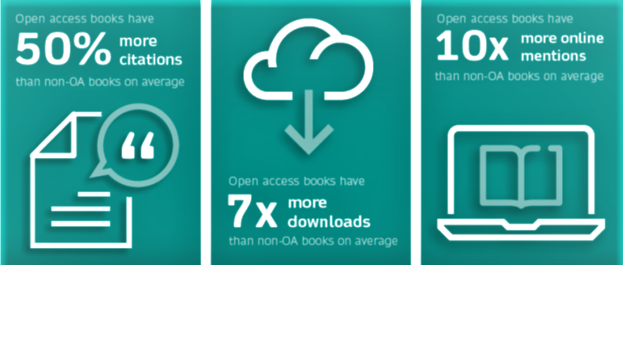
Open Access publishing has shown steady growth
A new study shows that, over the past 15 years, Open Access grew rapidly. According to the study done by Piwowar et al., Open Access articles account for 28% (or 19 million articles) of all scholarly literature. In 2015, around 45% of all scholarly articles were published or deposited on OA platforms. As a result of this remarkable growth, open access publishing has become one of the dominant publishing models. Open access articles are widely used and accessed. Moreover, Open Access articles are 18% more cited that non-Open Access. Now Open Access challenges the status quo and threatens traditional publishers.
There are four types of open access models identified by the researchers: Green, Gold, Bronze and Hybrid. According to this study Bronze OA is the one driving up the number of OA articles citation and its share in the industry. Green and Hybrid OA are also playing significant roles. The contribution of Gold OA is small, the study finds. The study, nonetheless, did not reveal why this is the case. Obviously, due to the cost associated with Gold OA, there are less number of Gold OA articles than Green and Bronze OA. Article Process Charges (APCs) could undermine the role of Gold OA in terms of citation impact and OA papers share, both a function of quality and quantity of OA articles published.
Subscription to journals cost universities and libraries millions of euros per year. The subscription cost increases on yearly basis; usually surpassing the rate of inflation. This has become a huge challenge both for institutions in developed and developing countries. Access-fee-related challenges are forcing researchers and libraries to resort to OA articles and OA repositories.

Open Data: policy initiatives and its growth challenges
Open access has been embraced by scholars, universities, policy makers, funders, and NGOs. Countries have put open access policies in place, publishers made open access their only business model and traditional publishers are gradually embracing open access. As a result, open access is steadily growing.
One component of open access is open data. Research funders such as the European Commission, Gates Foundation, Wellcome Trust and others have been pushing disclosure of research data. They adopted open data policy primarily to ensure data reusability and transparency. They are exerting pressure on researchers to make both their research article and the underlying data openly accessible. However, researchers are lukewarm about the push for open data. Unlike publishing on open access platforms, researchers lack the enthusiasm to deposit their data on open data repositories. Only 20 to 30% of the researchers share or are willing to share their data.
On the other hand, about 44% of journals have an open data policy. Nonetheless, most of the journals are not doing enough to make sure that authors deposit their research data. However, there are journals with a stringent open data policy. Surprisingly, authors response to these journals is negative: they abandoned those publishers.
Several things might explain why this is happening. One of the factors that is discouraging authors from depositing their data on open data platform is costs associated with open data. Usually authors are required to pay for data hosting and reviewing. These cost hundreds of euros. Charging authors for data hosting is a misguided strategy, according to Tim Vines. He argues that data hosting cost should be covered by public or private funds- i.e. authors should be reimbursed. To stimulate open data, it might be appropriate for research funders to allocate a fund for data hosting and reviewing.

The African Academy of Sciences will launch next year AAS Open Research, an open access publishing platform, meant to exclusively serve researchers in the continent. The platform is based on F1000Research model. It will adopt post publication open peer-review process. This approach will remove time lag researchers face to publish their research output. AAS Open Research will be an alternative platform for young African researchers who usually face challenges to publish their research out on overseas journals.
Publishing on AAS Open Research is not free. Publishers will ask up to €200 Article processing charges (APCs). The publisher hopes that research funders will make funding available for APCs.

Open Access Academic Books are More Downloaded and Cited
A research conducted by Springer Nature reveals that publishing academic books on open access platforms have many benefits. This report, according to Springer Nature, is the first of its kind to make a comparative analysis of open access and non-open access academic books. The study highlights the benefits open access books has provided to authors, publishers, funders and to a society at large.
The research used three metrics to measure the impact of open access academic books: downloads, citations and online mentions. In addition to these quantitative measures, Springer Nature also investigated the motivations and experiences with open access of researchers in a qualitative manner, by interviewing researchers and funders.
Results of the quantitative research
Most importantly, this study finds that:
- open access books are downloaded seven times more
- over the past four years the number of citations that open access books received is 50% higher
- open access books are mentioned online 10 times more
Results of the qualitative research
The interviews with funders show that the open access requirements put in place by funders are ethically motivated. Funders find it primarily important that the results from the research they funded disseminates to a large audience and is without access barriers.
The interviews with the researchers, on the other hand, shows that open access publishing was not solely ethically motivated. Researchers care most about visibility of their research output. They desire that their work gets disseminated to the widest possible audience and that this work gets cited more.
However, the researchers that were interviewed are not convinced about the benefits of open access to achieve wider dissemination and more citations. Although the interviewed acknowledged the quantitative results of the study, they pointed out that the causality is not proven. Other reason for the increased downloads and citations of open access scholarly work were suggested, such as authors reputation and the topic of the books that are open access.
Isn’t this skeptical attitude of these researchers slightly ironic? Indeed, this study doesn’t prove causality. But knowing that 1) open access removes an access barrier, 2) open access books are downloaded and used more, can we really not infer (1+1=2) that open access is increasing visibility? Are we not ‘scientific’ enough if we believe this inference? Or are researchers perhaps too skeptical stressing the lack of evidence for causality?

Researchers are constantly under pressure from their faculty to publish articles. This enormous pressure forces researchers to publish their research output as frequently as possible. However, most of the time it is not easy to publish articles on high impact factor journals; rejection is pretty common. For instance, nature rejects 93% of articles it receives for publications. Moreover, it takes a long period of time to publish accepted articles. There is also high Article Process Charges (APCs) for Gold Open Access journals. Combination of all these factors force researchers to look for alternative avenues to publish their research output. No researchers are immune to these challenges. Yet, these are pretty much daunting challenges for researchers based in developing countries.
Publishing on open access journals is getting traction. As most of them are new, the rate of rejection is low. Besides, they do not have much work overload to keep authors to wait before they see their published articles online. Coupled with the emergence of open access journals, there are several predatory open access publishers, which promise fast track publishing: less time and money to publish articles. In fact, predatory publishers are fast and charge relatively low APCs. Nonetheless, predatory publishers do not provide high quality peer-review and editorial services. On top of that, predatory publishers target academics with a barrage of spam emails asking them to publish on what they claim to be Gold Open Access journals. All these issues combined together make scholars in developing countries victims of predatory journal publishers.

